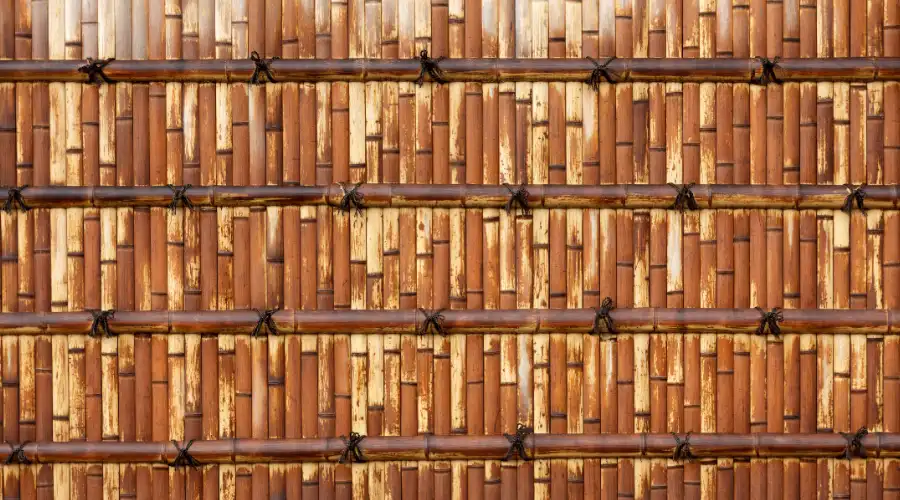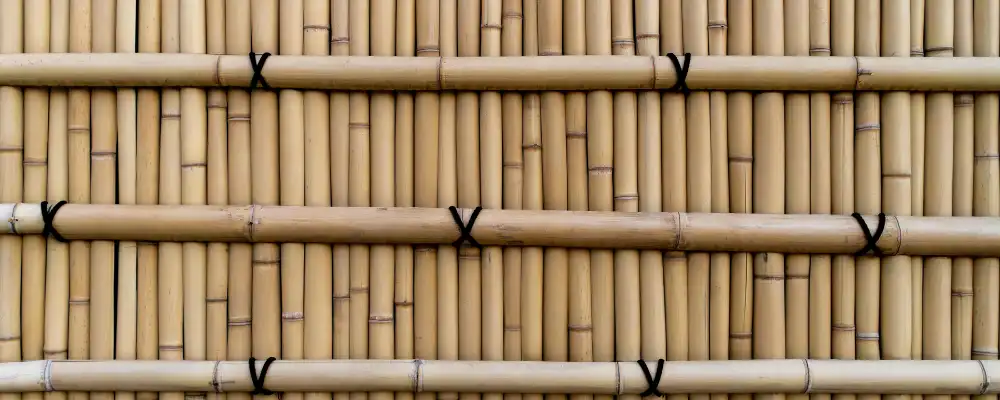In today’s constantly changing construction industry, we are becoming more focused on sustainability and being environmentally friendly. Bamboo serves as a good alternative to conventional materials for construction, especially for elements like compound walls. It is a fast-growing, high-tensile material, offering a range of opportunities in terms of sustainable architecture and construction. In this article, we will be discussing what bamboo compound walls are, what characteristics they have, their uses, their various types, installation process, and design factors.
What is a Bamboo Compound Wall?
A bamboo compound wall is an innovative solution for perimeter fencing around properties. Unlike the common concrete or brick walls, bamboo compound walls are an eco-friendly and economical solution for compound walls, built with the natural strength and flexibility of bamboo. These walls are not only functional, but decorative as well- they create a traditional aesthetic. Boundary bamboo compound walls can be constructed based on the design and structural requirements with raw bamboo, bamboo composites, or prefabricated bamboo panels. The use of local manpower and easily available materials makes the construction of these walls quite feasible.
Types of Bamboo Compound Wall Systems
Bamboo compound walls are versatile, eco-friendly, and durable. Here are the key types commonly used:
Woven Bamboo Walls
Thin bamboo strips are skillfully and intricately woven into mats, which are then attached to the chosen frame. Traditional Southeast and South Indian architectural styles commonly employ this type of wall. It provides excellent cross-ventilation and flexibility, making it one of the best options for seismic and flood-prone regions.
Vertical Half-Culm Walls
Bamboo culms are split into halves vertically and fastened through ties or mechanical fasteners to each other and/ or to a frame. This method results in a strong as well as a visually rhythmic wall. Such walls have good water resistance properties.
Wattle and Daub with Bamboo
This technique includes woven bamboo work (wattle) that has been coated with wood chips, mud, straw, or lime (daub). Such a combination provides excellent thermal insulation due to the use of earthen materials, thus functioning as an energy-efficient material.
Whole Bamboo Culm Walls
Entire cylindrical bamboo culms are arranged vertically or horizontally. They are either strapped or nailed to a frame for structural or ornamental purposes. These walls have good acoustic properties and require minimal labour to erect.
Split and Flattened Bamboo Walls
In this method, bamboo is either split or pressed into flat fronds, laid out for more surface coverage, and then tied together on a frame. This technique improves the strength of the material as well as enhances load distribution.
Bajareque Bamboo Walls
This is a traditional method of building walls in Latin America, in which bamboo is used to make wall frames and then coated with a mixture of mud and clay. Bajareque bamboo compound walls provide excellent insulation and are cost-effective.
Each type of bamboo wall system offers sustainability, strength, and aesthetic appeal for diverse construction projects.
Benefits of Bamboo Compound Walls

Bamboo compound walls have many outstanding benefits, including:
- Sustainability: Bamboo is a plant that grows fast and is renewable. It can easily be obtained from nature without the need for re-planting for the future. Some plant species have a particularly fast growth rate and reach their full size in just two years, while most other wood types will take between 30-50 years. Bamboo absorbs carbon dioxide from the atmosphere, making it an eco-friendly material.
- Strength and Durability: Bamboo’s tensile strength is quite comparable to steel, ensuring that the material will have a high life span. Despite being lightweight, it is sturdy and can withstand moderately harsh weather conditions for a very long time without becoming weak.
- Cost-Effective: This source is found to be so much more cost-effective than other conventional materials that it is even called the “green gold”. The material grows fast, has short cutting cycles (silviculture), and hence is one of the easiest and cheapest materials to use, especially when talking about large-scale projects.
- High Aesthetic Quality: The use of bamboo with various finishes gives the building a natural, affluent texture that does not seem out of place in urban or rural areas. The natural aesthetic reflected in the building is almost invaluable.
- Quick Construction: The installation of bamboo compound walls is relatively straightforward and they are also available in the form of prefabricated panels. Thus, the on-site construction time is greatly reduced and as a result, the labour costs are lower.
- Seismic Resistance: The characteristic flexibility of bamboo enables it to effectively absorb the vibrations produced by seismic waves. Thus, it is very suitable for earthquake-prone zones.
Applications of Bamboo Compound Walls
The technological advances in bamboo compound walls have led to their widespread and efficient use in many sectors. Some common applications include,
- Residential Properties: These are excellent for homeowners who wish to secure their housing layouts in an eco-friendly manner without having heavy brick masonry or permanent boundaries.
- Commercial Buildings: Businesses in the city wishing to contribute to a more sustainable world are choosing bamboo for boundary walls. With its distinctive texture and eco-friendly credentials, bamboo is an attractive option for commercial customers.
- Eco-friendly Communities: Similarly, eco-friendly communities like eco-villages or green housing projects prefer to employ walls made of bamboo composite to suit their environmentally friendly lifestyle.
- Urban and Rural Landscaping: In landscaping, bamboo compound walls are recognized for their decorative edging around gardens, parks, and leisure spaces.
Design Considerations For Bamboo Compound Walls
To design a bamboo compound wall, the following key considerations need to be considered to achieve utility and aesthetic appeal,
- Structural Integrity: Bamboo is a light material and may need structural support with materials like wood, concrete or steel to withstand heavy winds or severe rain, despite the strength of bamboo itself.
- Durability: Naturally stronger than oak, bamboo might nevertheless be susceptible to pests like termites. Thus, treatment and maintenance are crucial for a longer-lasting life. Decay and infestation can be fended away using protective creams and sealants.
- Aesthetic Integration: Bamboo compound walls must enhance the adjacent landscaping and general look of the property. Take the whole design of your property into account to make sure that the bamboo fence will be a complement to your home.
- Environmental Considerations: Be sure it’s sustainably sourced bamboo; select eco-treatments and finishes in the spirit of environmental health.
- Bamboo Species: There are around 1600 species of bamboo in the world. However, only around 50 of these are suitable for construction. Therefore, it is important to verify the qualities—such as species, length, thickness of wall and diameter—of bamboo before using it.
Step-by-Step Installation Process of Bamboo Panel Walls
1. Planning and Measurement
Initiate your work by taking a tour of the area, measuring the length, and determining the height of the wall required. Select the appropriate method for the bamboo wall and make sure to verify that your selected type is compatible with the local building codes and the surrounding environmental situation.
2. Site Preparation
See that the site is free from any kind of debris and vegetation, and is leveled and compacted. Such conditions are especially important for mud walling like bajareque or wattle and daub. Meanwhile, for framed panels or culm walls, a stable base should be constructed.
3. Foundation Setup
- Whole/Half Culm & Wattle Walls: Dig post holes or trench lines for frame posts.
- Panel & Flattened Bamboo: Prepare a level surface and secure concrete or wooden base frames.
- Wattle & Daub/Bajareque: Erect the bamboo lattice or skeleton frame first.
4. Wall Installation
- Woven/Flat Bamboo: Nail, tie, or screw woven mats or flattened strips onto support frames.
- Whole/Half Culms: Secure culms vertically/horizontally using dowels or fasteners.
- Panels: Bolt or screw the prefabricated bamboo panels to the frame or footing.
- Wattle & Daub: Fill the lattice with earthen daub mixture after drying.
5. Securing the Structure
For bamboo framing, it is quite easy to employ bamboo ties, metal fasteners, or rope bindings to make the joints secure and solid in cases of a natural disaster like an earthquake or strong winds.
6. Finishing
Apply natural sealants or borate solution to protect bamboo from moisture, pests, and UV rays. For more aesthetic finishes, consider limewash, lime plaster or eco-friendly paint.
Conclusion
Bamboo compound walls are an eco-friendly alternative to the traditional boundary walls that are widely used by people. As the walls are not only effective and sturdy, but also very economical, they can be ideally used in both residential and commercial sectors. With sustainability being the key to contemporary design, the future is bright for bamboo as a building material. The full perspective of advantages, the process of installation, and the design ideas for bamboo compound walls can enable house owners to decide if they would like to go green and use bamboo for their projects.

